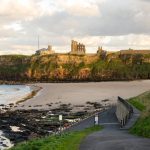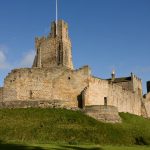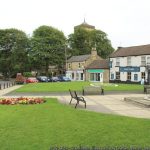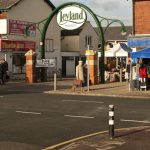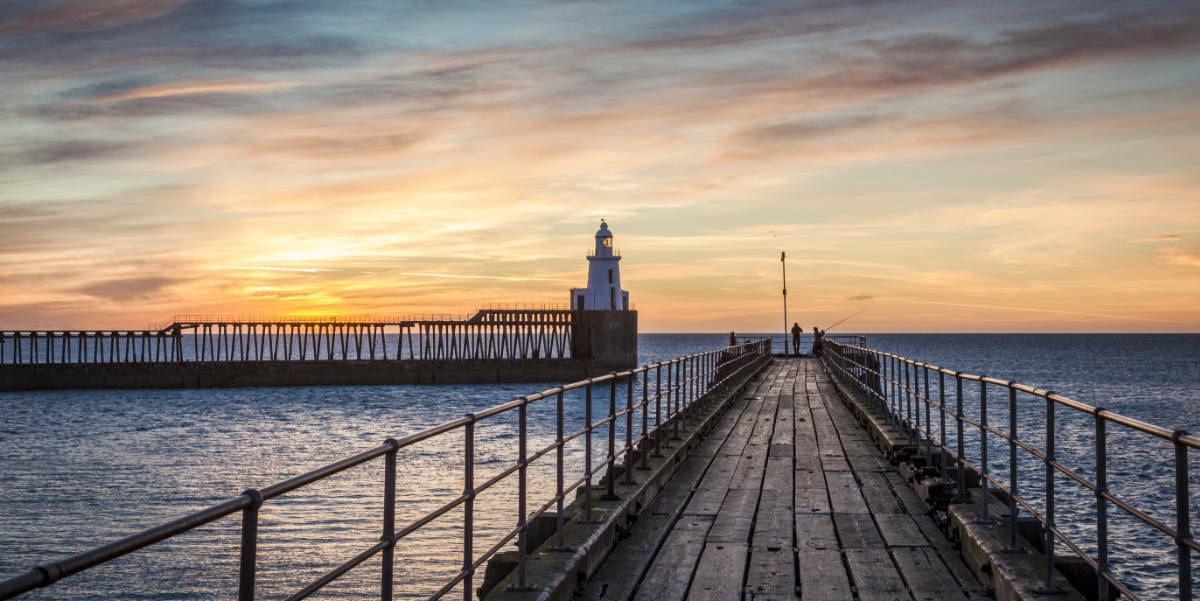
Looking for a seaside adventure in Northumberland? Coastal Blyth could be the best thing you and your family do this year. Here is everything you need to know before you go… Five Minutes Spare style.
Blyth is approximately 7 miles from Tynemouth and 13 miles from Newcastle. Over the years, the town has contributed both industrial goods and tourist attractions to Northumberland’s favourite cities. Nowadays, it is a thriving seaside port town bursting with summer tourism and seaside chip shops where you must fight off gulls to eat in peace. It’s the kind of place family memories are made of.
Let’s get stuck in with our five-minute guide to Blyth. Starting as per usual with a brief history.
The Ancient Village of Blyth
Archaeologists once found a Neolithic hammer in the area, made from antlers. Bronze age remains came from the river in 1890. There is evidence of earthen works nearby, but experts argue if they are Roman or Norse. The Vikings would raid along here around 800-1000AD. The questions seem to be over what was here to raid when they arrived. The earliest town records speak of the town named Blida, after the River Blida. Historians say the name was Blithmuth for a while. The town dropped the mouth over the years.
Originally the town was two townships, or one town and a settlement. South Blyth expanded so much in the Industrial era that it swallowed the inlet village of Cowpen. This may seem like a shame, but that early village lay on an inlet that allowed them access to salt plains. For hundreds of years, Cowpen made its living selling salt. By the time South Blyth swallowed it, the inlet flooded, and the salt plains vanished.
On a very interesting side note. We would normally look up what the Domesday Book said about anyone English town we studied. However, the Domesday Survey didn’t extend into Northumberland. After twenty years of occupying England, he still didn’t have full control of the north. So, we couldn’t find South Blythe or the village of Cowpen in the Domesday Survey.
Medieval Northumberland
Medieval Blyth was not a formal settlement of its own. There were a handful of settlements here as people came and went. Small-scale coal mining throughout the region meant locals were either miners, fishermen, farmers, or part of the salt trade. There was a natural harbour here, which meant a steady stream of occupation over the years. The largest settlements became South Blyth and Cowpen over the generations, right down until the 17th century when wealthy landowners moved in and started building infrastructure.
Fun Blyth Trivia
We like to interrupt this area of any given tour guide of England to review the local gossip. If there are highlights or lowlights of Blyth, you will find them in this section. Here are all the interesting talking points we could dig up about Blyth:
- The Ridley family made major investments here in the 1700s. They lived in Blagdon Hall, 8 miles away from Blyth. They still live there, ten generations down the line.
- Blyth comes from Blithe, the old English word for gentle and merry. This refers to the river, which is so gentle there are several fjords. The word blithe is still in use today, although it’s a rare one. It has evolved to mean easy-going and carefree.
- The first aircraft carrier built in the shipyards here was HMS Ark Royal. The former flagship was decommissioned in 2010. Locals of Blyth built it during WWII.
- The town’s marketplace contains concrete blocks which spell out the town’s name in morse code. Weird, but OK then.
- Captain William Smith set sail for new shores over 200 years ago now. Instead of finding a trade, he found Antarctica.
And on these fascinating notes, let’s get back to the history or we will be here all day.
The 17th Century and Industrial Blyth
From 1748, records show that locals were building ships in Blyth. Up until 1730, South Blyth was largely a fishing town with a small natural harbour. The first elevated staithe opened in 1788, marking the start of the industrial revolution. The High Light lighthouse opened in Bath Terrace. The lighthouse was decommissioned in 1985. In 1853, an act was passed whereby the locals could dredge the harbour. This made it large enough and deep enough for big ships to dock here.
By 1855, the town had a large coal mining industry, and the harbour was one of the busiest in the northeast. An estimated 250,000 tonnes of coal left this port in 1855. By 1901, this had turned into 3 million tonnes.
Coal Mining and Ship Building in the North
Coal mining began when landowners sunk the deep mines here in the 18th and 19th centuries. Miners worked long, hard hours deep underground. Unfortunately, the ship-building industry which carried the Brits through the war died off in the 60s. With the closure of the coal mines in the 80s and 90s, the town of Blyth went into stark recession. 28 other shipyards closed in the northeast. This is a story repeated up and down the north. Mass unemployment and poverty were rife in the early nineties.
In 1831 there were 246 houses containing 1,769 people. In 1931 this grew to 7,218 houses and over 31 thousand people. Coal mining and shipbuilding were such staples in the lives of the people here that it took massive amounts of refurbishing and updating to repair the damage. That repair work is still ongoing today, as we can see in the constant upgrades to the shores, shops, and town centre.
The Modern Town
During the wars, Blyth did its part both in the sacrifice of young men and in the building of a fleet of ships. Later, the 60s would see mass unemployment in the area. Trading estates like Kitty Brewster opened to fill the gap but it was not enough. Investments in the retail sector finally moved the main trades of Blyth away from the heavier, male-led industries and into gentler ones. New beaches, parks, and public spaces encouraged tourism, while the town still acts as a commuter town for Newcastle workers.
The local council opened Keel Row shopping Centre in 1991 to try and shore up the damage done by declining industries in the town. It worked. Big brands came to town, encouraging a thriving shopping community. Most industries closed in Blyth over the years as coal mining died out and the inlet at Cowpen became part of the river. However, to this day the port is still busy and flourishing. The town receives massive volumes of paper and pulp from Scandinavia. They ship this throughout the UK to newspapers.
The local council redeveloped the quayside and constantly improve the parks and beaches to attract tourism. The first two wind turbine farms in the UK sit across the river from Blyth, bringing more work to the area. Although now decommissioned, another company has erected turbines farther out to sea.
Modern Blyth is a picturesque town which the Industrial era could have sent another way. It has lovingly tended gardens, parks, beaches, and a busy port. It’s a great place to take kids that love ships or to spend a few days’ holiday. Have a look for yourself and add your thoughts on Blyth to our forum.
Famous People Who Lived Here
Now that we have finished with the historic facts, let’s cover the famous faces you might meet in town. You never know who will be at your local supermarket, so it’s best to go prepared.
- Paul Nicholson, is a pro darts player and winner of the Professional Darts Corporation.
- Mark Knopfler, the lead singer in Dire Straits, grew up as a Blythe boy.
- Captain William Smith as mentioned earlier, was the bloke who accidentally discovered Antarctica. Technically it was a set of islands just to the south. He named them the Shetland Islands, either imaginatively or because he thought that’s where he was. In return, they named Smith Island after him.
- Paul Lamb, the blues Harmonica player.
So, there are a few famous faces around, as you can see. You’re unlikely to meet Captain Smith in Tesco though. Heaven forbid.
The Best Attractions In and Around Blyth
This is everyone’s favourite section. In fact, we’d be willing to bet some of you just skipped the rest and came straight to the best things to see and do in Blyth. That’s cool, we don’t mind. But you missed the bit about the 3 million tonnes of coal. Here are the long-awaited Bluth attractions you should visit if you’re in town.
Historic Sites
One of the longest-running markets in the area, Blyth Market runs on Wednesday, Friday and Saturday. It operates as a flea market and as a car boot sale throughout the week. At the weekend, it turns into the kind of historic market that sells fruit and veg next to hand-carved recreations of the town square. Blyth is one of the biggest market towns in Northumberland – in fact, it’s one of the biggest towns, too. Shop till you drop and appreciate you are treading in the footsteps of millions who have come before you to buy incense and tealights they will never use.
Landmarks
The biggest landmark in Blyth is the port. This area of the town has a Battleship Wharf Terminal where you may get to see Royal Navy ships. There are ferries, deep-water transport vessels, and stacks of carriers just like you see in the movies. About 2 million tonnes of cargo pass through here annually, so it’s in full swing. Take the kids to see the big ships or just spend some time soaking up the energy. Stay away from the working areas though, for your own safety.
An epic landmark in Blyth port is the Battery. Blyth Battery features the big guns used to defend the port during the wars. Especially during WWI, the Germans would set their ships along the ports on the east coast and open fire. The Royal Navy responded by heightening port defences with big guns just like these ones. Important harbours need protecting from enemies – and as a result, you can visit them and experience the same shock and awe as the enemies did.
Galleries
There are only small galleries near Blyth. You could travel to the Newbiggin Maritime Museum to see some local artwork and a curated collection of fine pieces. You could also travel to the South Shields Museum and art gallery, which has a similar selection. You can visit the Tower House Gallery in Whitley Bay.
The only local galleries are Headway Arts and the recently opened Republic Gallery. You should find a good selection to choose from between them both. Headway Arts is a bit more of a studio space which encourages community collaborations. Check it out.
Museums
Although not strictly a museum, you can learn all about the rich history of the port in the Blyth Port Heritage Centre. The Ports of Blyth Heritage Centre features an archive filled with letters, interviews, oral history sessions, plans, photographs, and every other record you can think of that might relate to a 700-year-old natural harbour.
They have several artefacts collected over the years, and even the records of who was transporting what and to where, back in the 19th century. They have a full room of ship and harbour plans. These not only detail the layout of the port but also record how certain ships are put together.
If you care to head south and visit the lovely Whitely Bay for an afternoon, you could stop in at the Tynemouth Volunteer Life Brigade centre. They need all the donations you must give. They opened in 1864 and volunteers on this stretch of coastline have been saving lives every year since. Go have a gander and be sure to give generously.
Sports & Teams
Although not technically sports teams, there are sports you can learn in Blyth that you can’t take up in a landlocked town. For example, they have their own diving school, which lets you get up close and personal with the local deep sea wildlife. You can attend the local surfing school instead if you prefer.
This would teach you a valuable new skill that helps keep you fit. Alternatively, head out into the hills with local sightseeing and tour groups, who can take you hiking, biking, and trekking through the local landscape.
Blyth Cricket and Rugby Club is a weird blend of sports but it is in the east end of town. They describe themselves as a community sports club which provides entertainment for both children and adults. They are family orientated and welcoming. Go along and catch a game or a match? We’re not sure if they blend the two. Could be fun.
Since Blyth was originally two towns, they have ended up with two football clubs and a junior team. You can go see Blyth Spartans who at the time of writing play in the National League North (tier 6). They have a bit of FA Cup giant-killing history too.
At a more grassroots level, the town also has Blyth Rangers & Blyth Town FC. The latter in particular has a lot of junior teams both for boys & girls which is good to know if you are thinking of relocating here.
As for golf, there are always plenty of clubs in any given British town. You can go to your nearest club, which is Blyth Golf Club. They have a beautifully peaceful course with a few mild slopes. It is notorious in the region as one of the toughest courses in the northeast.
The first six holes, so they say, are the worst. Asides from the Blyth club there is the Arcot Hall Golf Club about 9 miles away, and the Bedlingtonshire golf Club slightly less than 9 miles away.
Outdoor Recreation

Image: Aarkanum/Shutterstock.com
Blyth Beach is one of the main draws in town. Every summer weekend when the weather is nice, Newcastle residents flock out to the seaside towns to soak up some sun. Blyth Beach is one of those beaches. Wander along this sunny stretch of sandy beach, which is backed by natural sand dunes.
These dunes act as coastal defences and prevent erosion. Blyth beach has a lovely set of huts for rent, but you will have to get in quick. There is excellent sea fishing here and there are toilets, a play park, and a few cafes and fish and chip shops along the front. Dolphins, seals, and porpoises frequent the beach. You should always check the tide times before you go.
The kids love Ridley Park, which provides an awesome playpark space for them to make new friends. The park has an area of fountains in which the children are almost encouraged to play, so expect them to get wet. There are gorgeous flower beds here and beautiful lawns. Grown-ups will be glad to know that there is a small café inside the park where they can get tea and a scone. Everyone loves a good scone.
Blyth has its own sports centre. The recreation centre has a swimming pool that comes with the basics. They occasionally run lane swimming or children’s swimming lessons. It is a fun way to learn how to swim. You can also go to the gym here or rent out a space for hire to hold your own dance class or event.
Shopping/Retail
The main shopping mall is the Keel Row Shopping Centre. They have all the big brand retailers you’d expect, including pop-up retail units in the style of beach huts. Market vendors use these in the summer months to sell trinkets. Apart from Keel Row, the town centre and the area nearby the port have some great shops.
There’s a B&M anyway, so we can all rest easy. England wouldn’t be England without at least one shop you entered for a four-pack of batteries and came out with a chiminea and a new raincoat for the dog.
Those of a thespian bent will enjoy knowing that there is a theatre in town. The Phoenix Theatre in Blyth is a sit-in auditorium-style cinema. They show all the current favourites and even have a summer cinema club for the little ones. If they have popcorn and pick-a-mix, we are happy.
Catch a pint at The Mason’s Arms and enjoy coffee at Ginevra Espresso. Blyth also has a Mecca Bingo for your entertainment.
Attractions in Greater Northumberland
There are other attractions nearby you should check out if you are in Blyth. The seaside and port town are nice, but you can head out into Northumberland to see some other neat places. We suggest the following:
- Tynemouth lies only a few miles along the coast.
- The Holy Island lies off the coast.
- There are two gorgeous castles nearby. Check out Bamburgh Castle or Alnwick Castle, which was a Harry Potter film location.
- You should check out Lindisfarne Castle while you are there.
Those should keep you busy until we reach our next travel guide.
How to get to Blyth?
It won’t be a great holiday if you can’t get there. Here are some directions but follow them at your own peril.
By Road
Follow the A1 north or south until you turn west at the A189.
By Rail
At the time of writing the nearest station is Widdrington. Watch this space though. The council approved plans for a new station in January of 2022.
By Air
The nearest airport is Newcastle International.
By Sea
Look for the Port of Blyth, which is a deep harbour.
UK Travel Guides by Five Minutes Spare
Here at FiveMinutesSpare.com, we offer travel guides to most of the major towns and cities in England. If we haven’t covered your town yet, it’s probably just a matter of time. Have a browse through our travel guides before you pick a holiday destination. Alternatively, drop us a follow on Facebook to show your support.
Header Image: coxy58/Shutterstock.con
